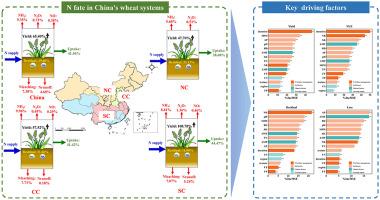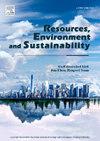中国小麦系统氮素命运的空间分异:区域管理的元分析和机器学习路线图
IF 7.8
Q1 ENVIRONMENTAL SCIENCES
引用次数: 0
摘要
在减少污染的同时优化作物生产力需要对氮肥的命运及其损失途径有一个全系统的了解。然而,中国小麦系统氮素命运的区域变异及其与产量响应的联系仍然缺乏量化。我们收集了4077个观测值,利用meta分析和机器学习分析了氮肥管理、气候和土壤性质对小麦产量、氮素去向和活性氮(Nr)损失的影响。在全国范围内,施氮可使小麦产量提高65.40%,施氮分为吸收量41.56%、残量29.66%和损失38.81%。Nr损失包括NH3(9.35%)、N2O(0.73%)、NO(0.38%)、淋滤(7.38%)和径流(4.68%)。在区域尺度上,氮素吸收呈现自北向南增加的趋势,氮残量和氮损失逐渐减少。NH3挥发占华北地区氮素总损失的91.76%。在华中地区(CC), NH3损失占53.45%,N淋失占41.38%。相比之下,中国南方(SC)表现出更均匀的损失分布。施氮量是氮素去向的关键决定因素,而pH、年平均降水量、年平均温度和容重对氮素损失影响最大。在全国范围内,氮素吸收是产量响应的主要驱动力,占变异的54.06%。从区域上看,吸收仍然是CC(37.83%)的关键因素,而NC(27.33%吸收量,16.09%损失)和SC(15.20%吸收量,12.37%损失)对N损失表现出相当大的敏感性。氮素残留量在大多数地区影响最小,但在CC显著(11.66%)。提高氮素吸收是中国不同地区小麦增产的首要任务,而氮肥损失和剩余的作用因地区而异。因此,氮管理应优先考虑NC和SC的损失减少,CC的剩余管理。本文章由计算机程序翻译,如有差异,请以英文原文为准。

Spatial divergence of nitrogen fate in China's wheat systems: a meta-analysis and machine-learning roadmap for region-specific management
Optimizing crop productivity while mitigating pollution requires a system-wide understanding of nitrogen (N) fertilizer fate and its loss pathways. However, regional variability in N fate and its linkage to yield response in China's wheat systems remains poorly quantified. We collected 4077 observations to analyze the effects of N fertilizer management, climate, and soil properties on wheat yield, N fate, and reactive nitrogen (Nr) losses using meta-analysis and machine learning. At the national scale, wheat yield increased by 65.40 % with N fertilization, with applied N partitioned into 41.56 % uptake, 29.66 % residual, and 38.81 % losses. The Nr losses comprised NH3 (9.35 %), N2O (0.73 %), NO (0.38 %), leaching (7.38 %), and runoff (4.68 %). At the regional scale, N uptake exhibited an increasing trend from north to south, whereas N residual and N loss gradually decreased. NH3 volatilization accounted for 91.76 % of total N loss in northern China (NC). In central China (CC), NH3 constituted 53.45 % of the losses, with N leaching accounting for 41.38 %. By contrast, southern China (SC) showed a more even distribution of losses across pathways. N application rate was the key determinant of N fate, whereas pH, mean annual precipitation, mean annual temperature, and bulk density had the greatest influence on Nr losses. Nationally, N uptake was the dominant driver of yield response, accounting for 54.06 % of the variation. Regionally, uptake remained the key factor in CC (37.83 %), whereas NC (27.33 % uptake; 16.09 % loss) and SC (15.20 % uptake; 12.37 % loss) showed substantial sensitivity to N loss. N residual had minimal impact in most regions but was significant in CC (11.66 %). Enhancing nitrogen uptake is the top priority in increasing wheat yield across different regions of China, while the role of fertilizer N loss and residual regionally varied. Accordingly, N management should prioritize loss reduction in NC and SC, and residual management in CC.
求助全文
通过发布文献求助,成功后即可免费获取论文全文。
去求助
来源期刊

Resources Environment and Sustainability
Environmental Science-Environmental Science (miscellaneous)
CiteScore
15.10
自引率
0.00%
发文量
41
审稿时长
33 days
 求助内容:
求助内容: 应助结果提醒方式:
应助结果提醒方式:


